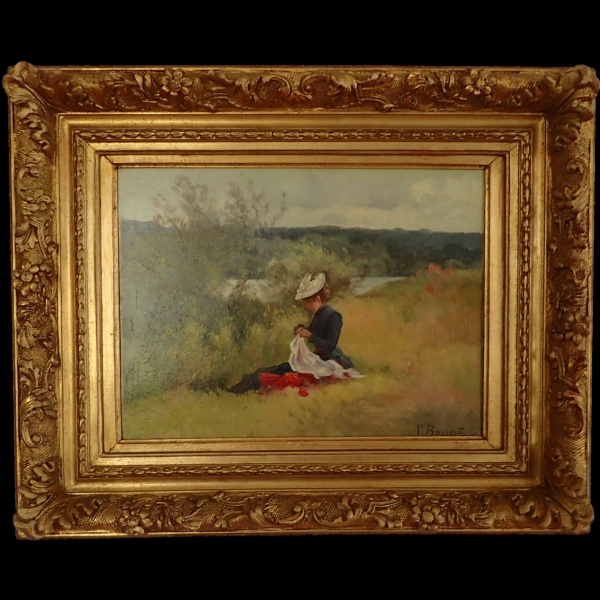Lovely Lady At the Water’s Edge by Paul Rossert

Oil on Panel of a Lovely lady by the water’s Edge by Paul Rossert.
This painting reflects the perfect illustration of ‘pleinairisme’ or the Outdoor school of painting.
At that time, the rise of the railroad allowed painters to travel easily to the countryside around Paris to explore nature and express their talents.
The goal was to relay the variations of light, the transience of the air, the shimmering of the water, to render a sensitivity, a lived experience of nature.
In this magnificent interpretation of a bucolic scene, we discover an elegant woman, sitting in the high grass, on a river background.
If the central character is enhanced with bright colors, contrasting sharply with the surrounding grass and bushes, the whole composition is treated with great softness and balance.
To reinforce the effect of perspective, the artist has elaborated his painting so that the eye follows from left to right the line defined by the field of grass, to finally reach the crest of the hill at the top right of the frame. The river narrows in the same way to accentuate the effect of depth and to give the eye an escape route.
In the pure impressionist style, the painter has proceeded by small touches of different colors arranged side by side, to create this impression of both softness and relief.
The most striking contrast comes from the choice of the different tones used. In the foreground, the acidulated tones surround the character to give her more relief, while the hill appears wilder in darker mauve tones.
Paul Rossert was born in 1851 in Lannoy (Nord), he was successively the student of Jules Noël, Carolus Duran, and Henri Lehnmann.
He liked to paint beach scenes and landscapes of Normandy, decorated with elegant women in crinolines, in the same way as his friend Eugène Boudin.
Proceeding with fine colored touches, he knew how to render the spirit of places and characters with an infinite accuracy in a very personal style.
His country scenes are reminiscent of Claude Monet’s, while his beaches are close to those of Eugène Boudin.
He exhibited regularly at the Salon des Artistes Français between 1875 and 1912.
He died in 1918.
His works are present in the museums of:
La Rochelle
Saint Brieuc
Trouville
the Panel measures: 10.43 inches high x 13.77 inches long.
France 19th Century c.Reference number: R-325
Click here to print.
go back
